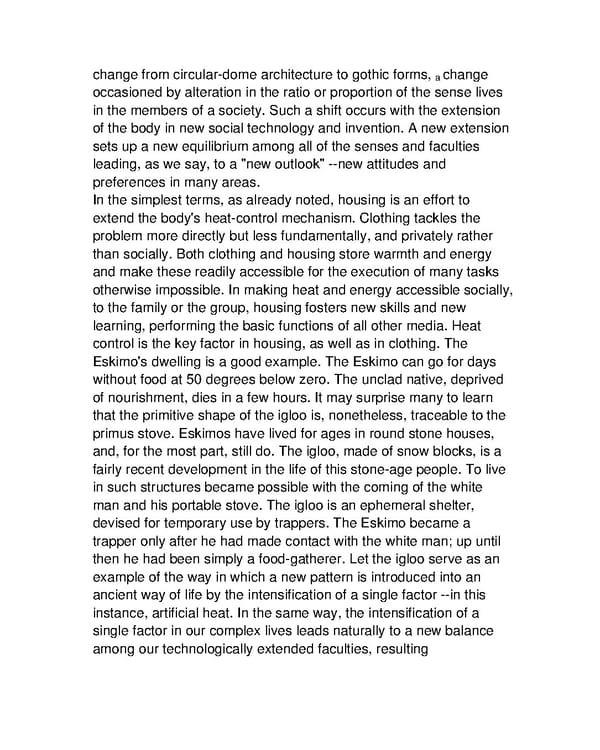change from circular-dome architecture to gothic forms, change a occasioned by alteration in the ratio or proportion of the sense lives in the members of a society. Such a shift occurs with the extension of the body in new social technology and invention. A new extension sets up a new equilibrium among all of the senses and faculties leading, as we say, to a "new outlook" --new attitudes and preferences in many areas. In the simplest terms, as already noted, housing is an effort to extend the body's heat-control mechanism. Clothing tackles the problem more directly but less fundamentally, and privately rather than socially. Both clothing and housing store warmth and energy and make these readily accessible for the execution of many tasks otherwise impossible. In making heat and energy accessible socially, to the family or the group, housing fosters new skills and new learning, performing the basic functions of all other media. Heat control is the key factor in housing, as well as in clothing. The Eskimo's dwelling is a good example. The Eskimo can go for days without food at 50 degrees below zero. The unclad native, deprived of nourishment, dies in a few hours. It may surprise many to learn that the primitive shape of the igloo is, nonetheless, traceable to the primus stove. Eskimos have lived for ages in round stone houses, and, for the most part, still do. The igloo, made of snow blocks, is a fairly recent development in the life of this stone-age people. To live in such structures became possible with the coming of the white man and his portable stove. The igloo is an ephemeral shelter, devised for temporary use by trappers. The Eskimo became a trapper only after he had made contact with the white man; up until then he had been simply a food-gatherer. Let the igloo serve as an example of the way in which a new pattern is introduced into an ancient way of life by the intensification of a single factor --in this instance, artificial heat. In the same way, the intensification of a single factor in our complex lives leads naturally to a new balance among our technologically extended faculties, resulting
 Understanding Media by Marshall McLuhan Page 140 Page 142
Understanding Media by Marshall McLuhan Page 140 Page 142